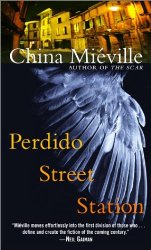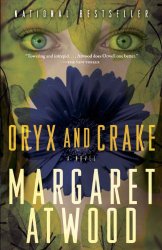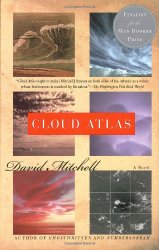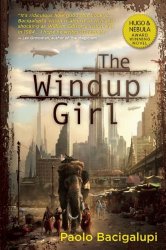Biopunk is a flavor of science fiction that focuses on intended (and unintended) consequences of biotechnology.
As a lapsed marine zoologist, I have special love for biopunk. While I think cyberpunk has done a great job in predicting the near future (computers and screens everywhere, mass surveillance, rule by corporation), my money’s on biopunk for the long haul.
Nature’s had a multi-billion-year head start on us on creating all manner of living things, while we’re just starting to figure out how biology really works. And being human, we start screwing around with things long before we understand it.
It’s only a matter of time before kids start finding My Very First Genetics Lab under the Christmas tree and start trading actual home-grown creatures like they were Pokemon.
3D printers are great, but I’m waiting for bioprinters. In 30 years, I expect to be able to download and print a living squirrel. I don’t what I’d do with it, but by god, I’d have a squirrel.
In America after the Second Civil War, the Pro-Choice and Pro-Life armies came to an agreement: The Bill of Life states that human life may not be touched from the moment of conception until a child reaches the age of thirteen. Between the ages of thirteen and eighteen, however, a parent may choose to retroactively get rid of a child through a process called “unwinding.” Unwinding ensures that the child’s life doesn’t “technically” end by transplanting all the organs in the child’s body to various recipients. Now a common and accepted practice in society, troublesome or unwanted teens are able to easily be unwound.
So if you’re a jerky kid, you better start behaving around the fifty-first trimester.
“Gripping, brilliantly imagined futuristic thriller…The issues raised could not be more provocative—the sanctity of life, the meaning of being human—while the delivery could hardly be more engrossing or better aimed to teens.”
-Publishers Weekly (starred review)
Over the space of five days of an Istanbul heat wave, six lives (a retired economist, a nine-year-old boy, a rouge trader, a recent graduate, an art dealer and a slacker) weave a story of corporate wheeling and dealing, Islamic mysticism, political and economic intrigue, ancient Ottoman mysteries, a terrifying new terrorist threat, and a nanotechnology with the potential to transform every human on the planet.
Some readers love author McDonald’s prose and pacing, while others were bored with long descriptions, annoyed by too many characters, and infuriated by bad behavior from all the protagonists. Also avoid if you are annoyed by the present tense.
“To read McDonald is to fall in love with a place and to become drunk with it….If you’ve never read him, you’re in for a treat. If you’re a fan like me, you’ll be delighted anew. What a wonderful, wonderful book.”
—Boing Boing
In this first book of the YA Leviathan trilogy, an alternate World War I is fought by steampunk machines and genetically-fabricated monsters.
“Enhanced by Thompson’s intricate black-and-white illustrations, Westerfeld’s brilliantly constructed imaginary world will capture readers from the first page. Full of nonstop action, this steampunk adventure is sure to become a classic.”
-School Library Journal (starred review)
The Glass Bees follows two days in the life of Captain Richard, an unemployed ex-cavalryman who feels lost in a world that has become more technologically advanced and impersonal. Richard accepts a job interview at Zapparoni Works, a company that designs and manufactures robots including the eponymous glass bees. Richard’s first-person narrative blends depiction of his unusual job interview, autobiographical flashbacks from his childhood and his days as a soldier, and reflection on the themes of technology, war, historical change, and morality.
Receiving mixed critical reception when published, Jünger’s riffs on the future of technology, variously interpreted as technophobic allegory or insightful critique into the altered relationship between technology, nature, and the human, have received renewed attention.
Not since Isaac Asimov has anyone combined SF and mystery so well. A very rich man dies unexpectedly, and when his backup copy is animated, he hires Takeshi Kovacs to find out why.
Morgan creates a gritty, noir tale that will please Raymond Chandler fans, an impressive accomplishment in any genre.
“Ribofunk,” a combination of “ribosome” and “funk,” is an alternate name for biopunk, and intends to connote a more positive view of the world than anything-“punk” can.
Personally, I think “biofunk” is a better choice, but if I really want to push that term forward, I’ll have to write a fantastic collection of short stories like Paul Di Filippo did in his book Ribofunk. In all of these eleven stories, biology is the science that drives the engine of life and of story: the Protein Police patrol for renegade gene-splicers; part-human sea creatures live in the Great Lakes and clean up toxic spills; a river has become sentient; there’s a bodyguard who is part wolverine and a thrill-seeker who climbs a skyscraper and gets stuck, literally.
“Despite occasional obscurity, Di Filippo’s effervescent prose can provoke both hilarity and haunting reflections on our species’ possible fate.”
-Publishers Weekly
Beneath the towering bleached ribs of a dead, ancient beast lies New Crobuzon, a squalid city where humans, Re-mades, and arcane races live in perpetual fear of Parliament and its brutal militia. The air and rivers are thick with factory pollutants and the strange effluents of alchemy, and the ghettos contain a vast mix of workers, artists, spies, junkies, and whores.
“Miéville’s canvas is so breathtakingly broad that the details of individual subplots and characters sometime lose their definition. But it is also generous enough to accommodate large dollops of aesthetics, scientific discussion and quest fantasy in an impressive and ultimately pleasing epic.”
-Publishers Weekly
First book in the well-regarded Xenogenesis trilogy, Dawn is often called both brilliant and disturbing. The protagonist goes through serious hell, so if you’re after a light read, this probably isn’t it.
Lilith lyapo awoke from a centuries-long sleep to find herself aboard the vast spaceship of the Oankali. Creatures covered in writhing tentacles, the Oankali had saved every surviving human from a dying, ruined Earth. They healed the planet, cured cancer, increased strength, and were now ready to help Lilith lead her people back to Earth—but for a price.
It’s odd to attach the “punk” name to something as mainstream as Jurassic Park, but if the claw fits, wear it. Like Frankenstein, Jurassic Park explores the unintended consequences of biological tinkering.
I’m going to assume you know the story, and instead tell you how Michael Crichton realized “there is no pressing need to create a dinosaur,” except perhaps for entertainment. Thus, the idea of an amusement park was born.
The first drafts of Jurassic Park were told from the point of view of a child, but fortunately, the author’s friends told him to change it.
Author Atwood does not consider Oryx and Crake to be science fiction because it does not deal with “things that have not been invented yet.” Instead, she categorizes it as “adventure romance.” So you’ve been warned.
It does, however, feature the effects of genetic engineering, climate change run wild, and primitive semi-humans.
The Island of Dr. Moreau is one of H. G. Wells’ first science fiction books, and he called it “an exercise in youthful blasphemy.”
A shipwrecked man comes across an island ruled by a mad surgeon-turned-vivisectionist who performs ghoulish experiments in an attempt to transform animals into men, with monstrous results. It is one of Wells’ earliest and most sinister personifications of the scientific quest to control and manipulate the natural world, and, ultimately, human nature itself.
This novel has been adapted into several movies, as well as serving as the inspiration for the Oingo Boingo song “No Spill Blood.”
Emotionally damaged people are sent to work next to a giant rift in the ocean floor, harvesting energy for surface dwellers. The workers are a bio-engineered crew—people who have been altered to withstand the pressure and breathe the seawater to work in this weird, fertile undersea darkness.
This book taught me that you can make a protagonist as crazy as you want, as long as what she’s battling against is even crazier.
Brilliant, twisted fun by an ex-marine biologist. Go read it.
In a future London, humans photosynthesize, organics have replaced electronics, viruses educate people, and very few live past forty. But Milena is resistant to the viruses. She’s alone until she meets Rolfa, a huge, hirsute Genetically Engineered Polar Woman, and Milena realizes she might, just might, be able to find a place for herself after all.
“A richly absorbing tale–with a marvelous premise expertly carried out.”
-Kirkus Reviews
You might have seen the movie: Cloud Atlas is six narratives, taking place in the 1850, 1930s, 1970s, and several dystopian futures.
“[David] Mitchell is, clearly, a genius. He writes as though at the helm of some perpetual dream machine, can evidently do anything, and his ambition is written in magma across this novel’s every page.”
—The New York Times Book Review
As children, Kathy, Ruth, and Tommy were students at Hailsham, an exclusive boarding school secluded in the English countryside. It was a place of mercurial cliques and mysterious rules where teachers were constantly reminding their charges of how special they were.
Now, years later, Kathy is a young woman. Ruth and Tommy have reentered her life. And for the first time she is beginning to look back at their shared past and understand just what it is that makes them special—and how that gift will shape the rest of their time together.
I’d tell you more about why exactly this book is both SF and biopunk, but it’d give too much away.
Best Novel of 2005
-Time Magazine
Anderson Lake is a company man, AgriGen’s Calorie Man in Thailand. Undercover as a factory manager, Anderson combs Bangkok’s street markets in search of foodstuffs thought to be extinct, hoping to reap the bounty of history’s lost calories. There, he encounters Emiko. Emiko is the Windup Girl, a strange and beautiful creature. One of the New People, Emiko is not human; instead, she is an engineered being, creche-grown and programmed to satisfy the decadent whims of a Kyoto businessman, but now abandoned to the streets of Bangkok. Regarded as soulless beings by some, devils by others, New People are slaves, soldiers, and toys of the rich in a chilling near future in which calorie companies rule the world, the oil age has passed, and the side effects of bio-engineered plagues run rampant across the globe.
“This complex, literate and intensely felt tale, which recalls both William Gibson and Ian McDonald at their very best, will garner Bacigalupi significant critical attention and is clearly one of the finest science fiction novels of the year.”
-Publishers Weekly
It’s been argued that Frankenstein; or, The Modern Prometheus is the first science fiction novel. It’s certainly the first biopunk (though who know what Shelley would have made of that term). Shelley published it anonymously in 1818, and 500 copies were printed.
It wasn’t until 1831 that the “popular” version was sold (which is probably what you’ve read). Shelley edited the book significantly, bowing to pressure to make the book more conservative. Many scholars prefer the 1818 version, claiming it holds true to Shelley’s original spirit.
Both Brave New World and 1984 saw dystopian futures, but Huxley seems to have gotten much of it right (though Orwell did nail the surveillance state). According to social critic Neil Postman:
“What Orwell feared were those who would ban books. What Huxley feared was that there would be no reason to ban a book, for there would be no one who wanted to read one. Orwell feared those who would deprive us of information. Huxley feared those who would give us so much that we would be reduced to passivity and egotism… Orwell feared we would become a captive culture. Huxley feared we would become a trivial culture, preoccupied with some equivalent of the feelies, the orgy porgy, and the centrifugal bumblepuppy.”
From the first novel, Software:
It was Cobb Anderson who built the”boppers”—the first robots with real brains. Now, in 2020, Cobb is just another aged “pheezer” with a bad heart, drinking and grooving to old tunes in Florida retirement hell. His “bops” have come a long way, though, rebelling against their subjugation to set up their own society on the moon. And now they’re offering creator Cobb immortality, but at a stiff price: his body, his soul … and his world.
“Rucker’s four Ware novels–Software (1982), Wetware (1988), Freeware (1997), and Realware (2000)–form an extraordinary cyberweird future history with the heft of an epic fantasy novel and the speed of a quantum processor.”
-Publishers Weekly
[mc4wp_form]




















Don’t forget “Oracle of Delphi” by James Gurley and “Stinger Stars” by Paul Bussard!
What about the Monster Blood Tattoo/Foundling’s Tale trilogy by D.M. Cornish? I know it’s more fantasy than science fiction, but it walks the line very finely. I remember having the greatest sense of wonder for how cool it was to have all the trappings of steampunk, but with surgical augmentations and sustainable biological technologies rather than engines and coal.
I hadn’t heard of this series—thanks for bringing it up. It looks pretty cool.
Fairy land by Paul J McAuley was my introduction to biopunk, well worth a read.
id add
Autonomous – Annalee Newitz
from wikipidea
Set in a near future Earth, the book describes a world where both humans and intelligent robots can be owned as property. The events of the novel follow Jack, a “drug pirate” who manufactures illegal versions of patented drugs, and Paladin, a combat robot who is owned by the law enforcement agency searching for Jack after one of the drugs she reverse-engineered turns out to have dangerous side effects.